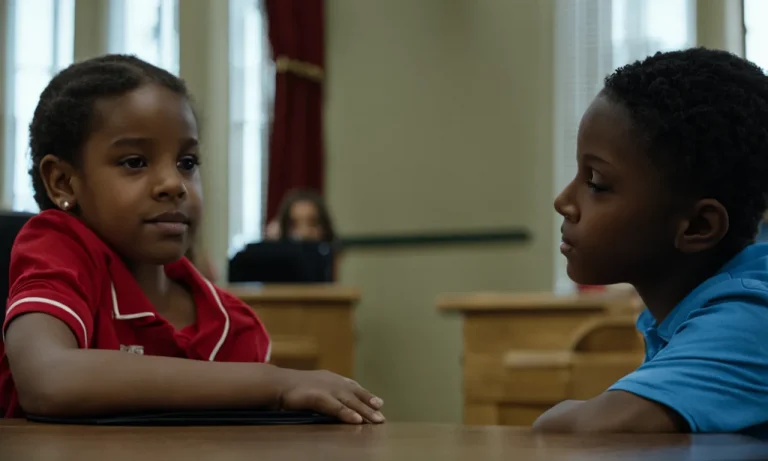Having a child miss school due to injury or illness is always a difficult decision for parents. If your child has recently sprained their ankle, you may be wondering whether they should take a few days off to rest and recover or if it’s okay for them to attend classes with a minor injury.
The quick answer is that in most cases, it is perfectly fine for a child to go to school with a mild or moderate ankle sprain as long as they are able to walk without significant pain and don’t need heavy pain medication.
However, each child and injury is unique, so it’s best to consult your pediatrician.
In this comprehensive guide, we’ll cover everything you need to know about sending your child to school with a sprained ankle. We’ll discuss the different grades of ankle sprains, provide tips on managing pain and swelling, review school accommodations that may help, and offer advice on when kids should stay home to heal.
Understanding the Different Grades of Ankle Sprains
Ankle sprains are a common injury, especially among children who are active and participate in sports or physical activities. If your child has recently sprained their ankle, you may be wondering whether they can still go to school.
The answer to that question depends on the severity of the sprain and the level of discomfort your child is experiencing.
View this post on Instagram
Grade 1 (Mild)
A grade 1 ankle sprain is the mildest form of sprain. It involves stretching or slight tearing of the ligaments in the ankle. In most cases, children with a grade 1 sprain can still attend school.
However, it is important to monitor their pain levels and provide appropriate support, such as crutches or a brace, if necessary. Encourage your child to take it easy and avoid activities that could worsen the sprain.
View this post on Instagram
Grade 2 (Moderate)
A grade 2 ankle sprain is a moderate injury that involves partial tearing of the ligaments. Children with a grade 2 sprain may experience more pain and swelling compared to those with a grade 1 sprain.
Depending on the severity and discomfort, it may be necessary for your child to stay home from school for a few days to allow the ankle to heal. Rest, ice, compression, and elevation (RICE) are recommended during this time to reduce swelling and promote healing.
View this post on Instagram
Grade 3 (Severe)
A grade 3 ankle sprain is the most severe type of sprain and involves a complete tear of the ligaments. Children with a grade 3 sprain will likely experience significant pain, swelling, and instability in the ankle.
In this case, it is generally advised to keep your child home from school until the pain and swelling subside and they are able to bear weight on the injured ankle. Physical therapy and rehabilitation may also be necessary to regain strength and stability in the ankle.
It’s important to consult with a healthcare professional if your child has sprained their ankle. They will be able to assess the severity of the sprain and provide appropriate guidance on whether your child can go to school or if they need to stay home for a period of time.
Remember, every sprain is unique, and the healing process can vary from person to person.
Managing Pain and Swelling at School
Elevation
One of the key ways to manage pain and swelling caused by a sprained ankle at school is through elevation. By propping up the injured ankle on a chair or desk, blood flow to the area can be reduced, which helps to minimize swelling.
Encourage your child to keep their foot elevated whenever possible throughout the school day. This simple step can make a significant difference in their comfort level.
Ice
Another effective method for managing pain and swelling is by applying ice to the sprained ankle. Ice helps to reduce inflammation and numb the area, providing relief. Consider packing a small ice pack or a bag of frozen peas in your child’s lunchbox so they can apply it during breaks.
It’s important to wrap the ice pack in a cloth or towel before placing it on the skin to prevent frostbite.
Compression
Using compression can also help alleviate pain and swelling. Encourage your child to wear a supportive ankle brace or wrap the affected area with an elastic bandage. Compression helps to stabilize the ankle and reduce fluid buildup.
It’s important to ensure that the compression is not too tight, as it can restrict blood flow.
View this post on Instagram
Over-the-Counter Medication
If the pain and swelling persist, your child can take over-the-counter nonsteroidal anti-inflammatory drugs (NSAIDs) such as ibuprofen or acetaminophen. These medications can provide temporary relief from pain and reduce inflammation.
However, it’s essential to consult a healthcare professional or pharmacist before giving any medication to your child, as they can provide guidance on the appropriate dosage and any potential side effects.
Remember, it’s crucial to communicate with your child’s school about their sprained ankle. Inform the teachers and school nurse about the injury and the steps being taken to manage pain and swelling. This way, they can provide additional support and accommodations if needed.
For more information on managing pain and swelling caused by a sprained ankle, you can visit WebMD or Mayo Clinic.
Asking for Accommodations at School
When a child has a sprained ankle, it can be challenging for them to navigate the school environment. However, with the right accommodations, they can still attend school and continue their education without any major disruptions.
Here are some accommodations that you can request from the school to help your child during their recovery.
Extra Time Between Classes
Walking between classes with a sprained ankle can be painful and slow. One accommodation you can ask for is extra time between classes. This will allow your child to move at a more comfortable pace and avoid straining their injured ankle.
By giving them a few extra minutes, they can arrive at their next class without feeling rushed or in pain.
Elevator Pass
If your child’s school has multiple floors and their classrooms are located on higher levels, requesting an elevator pass can be a great accommodation. This will enable your child to use the elevator instead of the stairs, making it easier for them to get to their classes without putting too much pressure on their sprained ankle.
The school may require a note from a healthcare professional to grant this accommodation.
Temporary Handicap Parking Permit
If your child needs to be dropped off or picked up from school by car, you can request a temporary handicap parking permit. This will allow you to park closer to the school entrance, making it easier for your child to access the building.
Additionally, it can reduce the distance your child needs to walk, minimizing the strain on their sprained ankle.
Modified PE Class
Participating in physical education classes with a sprained ankle can be challenging and potentially worsen the injury. By requesting a modified PE class, your child can still participate in physical activities that are safe and suitable for their condition.
This may involve alternative exercises or activities that focus on upper body strength and flexibility, allowing them to stay active while avoiding further harm to their ankle.
Remember, it’s important to communicate with your child’s school and provide any necessary documentation from healthcare professionals to support your accommodation requests. By working together, you can ensure that your child receives the necessary support to continue their education while recovering from a sprained ankle.
When to Keep Your Child Home from School
Severe Pain
If your child is experiencing severe pain, it is best to keep them home from school. A sprained ankle can be quite painful, especially in the first few days after the injury. Pain can make it difficult for your child to concentrate in class and can also slow down the healing process.
It’s important to allow your child to rest and recover at home, where they can elevate their leg and apply ice as needed.
Need for Heavy Pain Medication
If your child requires heavy pain medication to manage their sprained ankle, it may be best to keep them home from school. Strong pain medication can cause drowsiness and affect your child’s ability to focus and participate in class activities.
It’s important for them to have a quiet and comfortable environment at home where they can rest and take their medication as directed.
Difficulty Walking or Risk of Re-Injury
If your child is having difficulty walking or there is a risk of re-injury, it is advisable to keep them home from school. Walking on a sprained ankle can worsen the injury and delay the healing process.
Additionally, participating in physical activities, such as recess or gym class, can increase the risk of re-injury. It’s best to give your child time to fully recover before allowing them to return to their regular routine.
Fever or Other Flu-Like Symptoms
If your child has a fever or other flu-like symptoms along with their sprained ankle, it is important to keep them home from school. These symptoms could indicate an underlying illness, such as the flu, that requires rest and medical attention.
Additionally, attending school while sick can spread germs and make other students and staff members susceptible to illness.
Remember, it’s always best to consult with a healthcare professional if you are unsure whether your child should go to school with a sprained ankle. They can provide guidance based on the severity of the injury and your child’s overall health.
Returning to Sports and Physical Activities
If your child has recently sprained their ankle and you’re wondering when they can return to school and engage in sports and physical activities, there are a few important factors to consider. While every case is unique and should be assessed by a medical professional, here are some general guidelines to keep in mind.
Consult Your Doctor First
Before your child returns to school or participates in any physical activities, it’s essential to consult with their doctor or healthcare provider. They will be able to assess the severity of the sprain and provide tailored advice based on your child’s specific condition.
View this post on Instagram
Your doctor may recommend certain treatments, such as rest, ice, compression, and elevation (RICE), or they may suggest further evaluation, such as an x-ray or MRI.
Gradually Increase Activity
Once your doctor gives the green light for your child to resume physical activities, it’s important to gradually increase their level of activity. Start with light exercises and low-impact activities, such as walking or swimming, and gradually progress to more demanding movements and sports.
This gradual approach allows the injured ankle to heal properly and reduces the risk of re-injury.
Consider Ankle Brace for Support
To provide additional support and stability to the sprained ankle, you may want to consider using an ankle brace. An ankle brace can help prevent excessive movement and minimize the risk of further injury.
Consult with your doctor or a qualified sports medicine professional to determine the most suitable type of ankle brace for your child’s specific needs.
Watch for Re-Injury Risk
Even after your child has fully recovered from a sprained ankle, there is still a risk of re-injury. It’s important to monitor their activities and watch for any signs of discomfort or pain. Encourage your child to listen to their body and take breaks when necessary.
If your child experiences persistent pain or if the ankle becomes swollen or unstable, consult with their doctor for further evaluation.
Remember, each sprained ankle is unique, and the recovery time can vary depending on the severity of the injury. It’s essential to follow the advice of your child’s healthcare provider and allow them to return to sports and physical activities gradually and safely.
Conclusion
Deciding whether your child can attend school with a sprained ankle requires carefully weighing factors like pain levels and risk of re-injury. For mild sprains, kids often can continue classroom learning with some accommodations for comfort and mobility.
More severe sprains may require a few days of rest at home to heal. Being aware of pain management strategies and talking to school staff can help kids recover while minimizing time away from their normal routine.
With the right treatment plan and precautions, most kids can get back to school and activities after a minor ankle injury.






